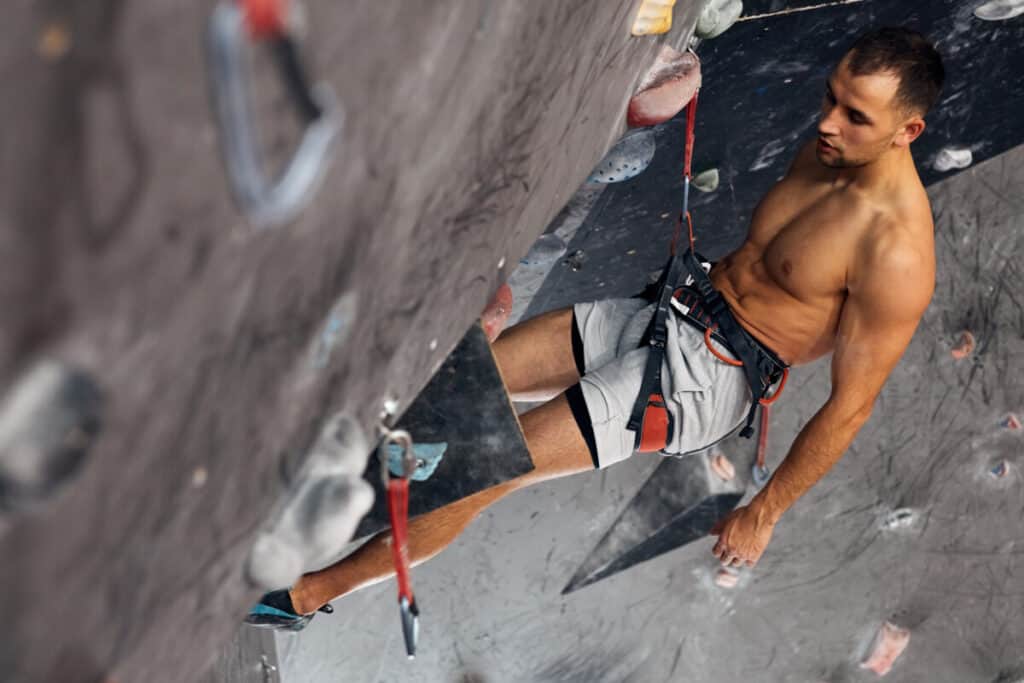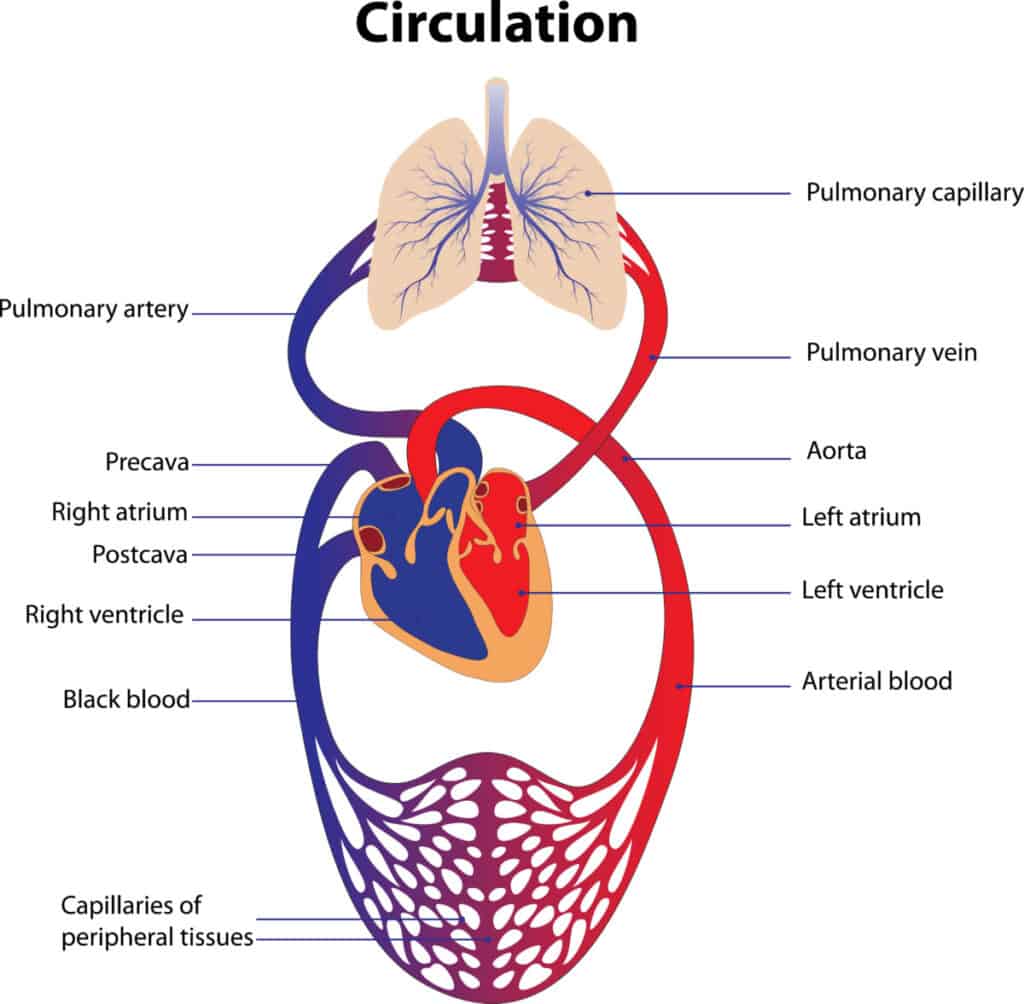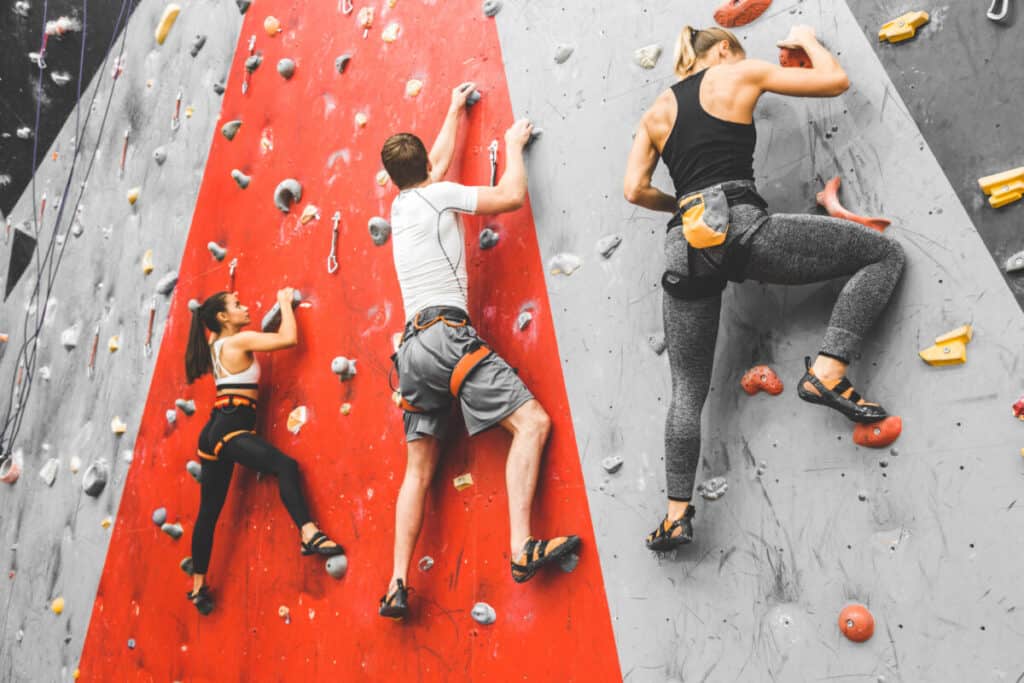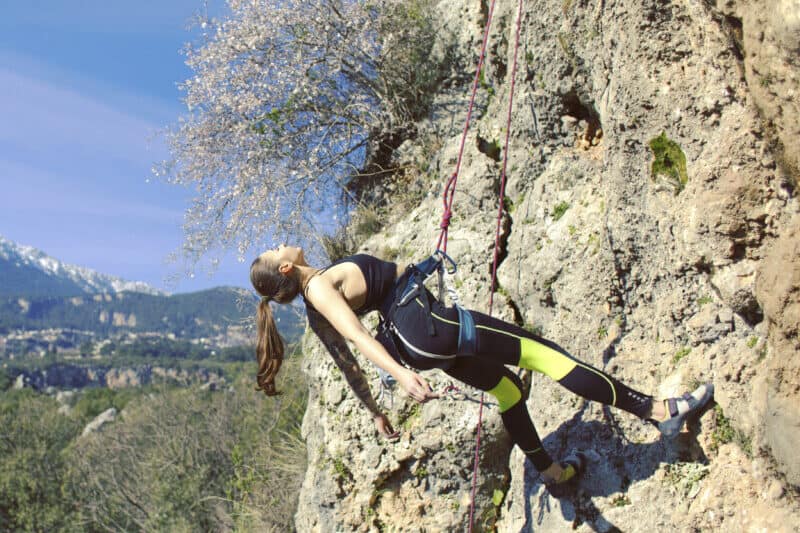
One of the challenges that many new climbers face is getting prematurely pumped. Getting pumped during a climbing session can be debilitating. When pumped, the forearms feel swollen, it is difficult to make a fist and the hands and fingers struggle to exert the necessary tension needed to sustain even the easiest of holds.
Although the exhilaration of climbing is second to none, one-and-done fatigue can chisel away at the climbing experience and waste valuable time and money at the climbing gym. Likewise, the quick pump and early hand fatigue slows the progression of a climber as fewer climbs = fewer opportunities to learn and perfect technique.
Four key elements play a significant role in building climbing stamina to avoid getting pumped: enhancing capillarization, building strength, warming up and improving technique.
I remember my first experience at the climbing gym. I was excited and eager and carefully chose a route (that happened to be 5.9) that I thought might pair well with my natural athletic abilities. I hopped onto the auto-belay and quickly realized that the climb was more difficult than I had anticipated. My ascent was terribly slow going. I had to have looked like such a newb. . .all arms, no legs. Eventually, near the top, I got stuck. I couldn’t figure out the move and my forearms were on fire. My knees started bouncing involuntarily, and my fingers started shaking on the hold as I desperatley tried to cleave onto the wall. It was a kind of a strange experience, like a timer counting down. . .3. . .2. . .1. Though I was still exerting maximum effort, my grip literally just. . .failed. I was caught by the auto-belay and I slowly slumped back down. I wanted to hop back on and try again. But my forearms felt swollen and my hands felt useless–I couldn’t even make a fist. I was one-and-one.
I remember looking around the gym at the other climbers. They didn’t seem to be that much stronger than me. At the time, I didn’t really know how to digest the phenomena. I figured they had just, “gotten used to it”.
And really, I wasn’t that far off. Building climbing endurance to stave off the climbing pump is really about “getting used to climbing”. Developing the capacity to hold heavy objects above the shoulders or to perform strenuous anaerobic exercises for long periods of time requires the body to make physiological changes to “get used to it”. But, make physiological changes it will—the body is a biological masterpiece of engineering that can adapt to new environments.
What Does “Getting Pumped” Mean in Rock Climbing?
What does it mean when a rockclimber says they are “so pumped”? It might sound strange for someone to hear this for the first time because it might seem a little out of context to be referring to excitement. It may also appear strange that other climbers around them might express empathy instead of shared exuberance.
In rock climbing, “getting pumped” refers to when the hands and forearms become overexerted. They ache, burn, swell and it is difficult to expand and contract them. Simple crimp and pinch holds become extremely difficult. Grips open up and relinquish their ability to lock onto holds.
Climbing challenging routes while pumped will eventually lead to maxing out—where all available energy is consumed and holds become literally impossible to maintain. Perhaps the greatest difficulty lands on the ego—calling down to the belayer that you’re “kinda pumped, can’t finish the route and need to be lowered” can sometimes be a shameful event. Both you and the belayer know the truth—you’re really pumped, you’ve already climbed beyond the “kinda pumped” threshold. You can’t hold onto anything—not even the rope while being lowered. Your arms hang useless at your sides all the way down. Hopefully, your belay partner will give you some privacy and let you spend some good one-on-one time with your figure eight knot for—as long as it takes.
Getting Pumped Explained at the Physiological Level
Getting pumped at the physiological level requires a more complex explanation. Muscles are able to expand and contract by using adenosine triphosphate (ATP)—a highly charged molecule as fuel. ATP is generated in a few different ways. The most sustainable source of ATP comes from cellular respiration and another, much less sustainable source, comes from lactic acid fermentation.
Cellular Respiration Provides 30 ATP through the Krebs cycle
Cellular respiration occurs during aerobic activities where the body is able to efficiently circulate blood throughout the body. The most productive and sustainable source of ATP comes from the muscle cell’s mitochondria use of oxygen to convert pyruvate (broken down glucose) into 30 ATP through what’s called the Krebs cycle.

Oxygenated blood is pumped from the heart and into arteries, arterioles, and then into capillaries so narrow that blood cells travel through single-file. These capillaries form a web around muscle tissue cells. Oxygen and glucose is diffused from the red blood cells into the muscle cell. With proper circulation, the mitochondria in the muscle tissue cells have plenty of oxygen to continuously cycle through the Krebs cycle and generate high outputs of ATP.
Lactic Acid Fermentation Generates 2 ATP
However, when muscles are in demand but the oxygen supply is limited during anaerobic workouts like climbing, the muscle tissue cells rely on lactic acid fermentation to obtain ATP. Muscle tissue cells are constantly converting glucose into pyruvate through glycolysis—a process that generates 2 ATP (fuel). The muscle tissue primarily uses glucose from available stores in the muscle cell. Simultaneously, pyruvate is constantly broken down into lactic acid. However, without the presence of oxygen, the muscle tissue can rely only on available stores of ATP and glucose to provide fuel for muscle expansion and contraction for about 30 seconds.
Without blood circulation, the muscle tissue cells do not have the oxygen needed to recycle the lactic acid back into pyruvate or filter it into the bloodstream. Instead, the lactic acid becomes concentrated in the muscle tissue which reduces the PH of the muscle tissue cell causing it to become acidic. This acidity and lack of ATP causes muscle fatigue, depletion, burning and or stinging. It’s the body’s way of informing the brain that muscle usage at those levels is not sustainable. This is the debilitating sensation climbers feel when getting pumped.
Lactic Acid Fermentation During Strenuous Anaerobic Exercise Does Not Produce Enough ATP for Muscles and the Muscles Get Pumped.
Acidity levels must be rebalanced by restored access to oxygen either via rest or light aerobic activities.
To avoid or delay the pump, climbers need to think about circulation and ways to improve circulation so the body’s blood flow through muscle tissue can have a more ample supply of oxygen while climbing.
This is where “getting used to it” comes into play.
Enhanced Capillarization is the Key to Staving Off the Climber’s Pump
The good news is that the more a climber climbs, or puts their climbing muscles in anaerobic demand, the body will automatically recognize that the climbing muscles need more access to blood and oxygen. More capillaries will form and will more densely surround the muscle tissue. Additionally, more mitochondria will be generated within the muscle tissue cells to compound the supply of ATP needed for anaerobic workouts and climbing.
As mentioned above, the heart pumps oxygenated blood to the location of muscle tissue from the arteries. From there, arterioles and capillaries further administer blood and nutrients to muscle tissue cells. Capillaries are extremely narrow and thin walled vestibules—so narrow that only single file blood cells can pass through. Capillaries form a web around each muscle tissue cell. Through the capillaries, blood cells deliver oxygen energy and nutrients to the muscle tissue and pick up any waste and byproducts. As the deoxygenated blood passes through the capillaries in the muscle tissue it reconnects with venules and veins where it is then detoxed by the liver, kidneys and lungs. The blood is then reoxygenated through the heart and lungs and then recirculated back through the arteries, arterioles and capillaries around the muscle tissue.
As more oxygen levels are needed during anaerobic activity, the body will stimulate the growth of more capillaries to facilitate enhanced circulation.
This is how the body “gets used to it”.
Climbers can stimulate capillary growth by acclimating the body to anaerobic climbing conditions. Capillary density can be enhanced. There are several methods used to stimulate capillary growth.
How to Enhance Capillarization for Rockclimbing
ARC (Aerobic Restoration and Capillary) Training Stimulates Capillarization

ARC (Aerobic Restoration and Capillary) training is a method commonly used to help climbers enhance capillary growth and density through prolonged climbing sessions of 20-45 minutes. When the blood vessels are dilated during frequent and prolonged periods of time, they stimulate the growth of more capillaries and enhance capillary density in efforts to maximize blood flow. ARC training methods focus on endurance—maximizing the amount of time spent climbing by reducing the difficulty of climbing routes and problems to 2-3 grades below max. The climber should be familiar with the route or problem, or, it should be easy enough for the climber to be able to efficiently navigate through it—maintaining aerobic movement and stimulating blood flow.
When ARC training, the climber is likely to experience a light pump after 5 or 10 minutes. However, by keeping the difficulty level 2-3 grades below max and maintaining aerobic movement, the climber should be able to climb through the pump. If the climber feels like they reach anaerobic thresholds or feels excessively pumped they either need to tone it down or take a quick break—resuming as soon as possible.
It is important to focus on technique while ARC training.
Climbers have a tendency to get sloppy when climbing routes below max. Stay focused and precise and gradually increase the difficulty of the ARC climbing routes as stamina is enhanced.
Four Most Common ARC Training Methods
- Scatter board. A scatter board is practically designed specifically for ARC training and contains a plethora of different holds for the climber to continuously maneuver around on.
- Traversing. Traversing is another common ARC training method and involves climbing back and forth along the base of a climbing wall or bouldering gym.
- Auto belay. Auto belay stations can also be a great way to ARC train. They allow the climber to scale up and down and offer various route options for the climber to scale climbing difficulty.
- Belay partner. And finally, climbers can ARC train with a belay partner on easier routes with lots of different holds.
Some climbers add an ARC training regime at the end of a climbing session. All of these ARC training methods require lengthy blocks of time on the climbing area and it’s important to be considerate of other climbers. If courtesy only allows a few minutes on the auto belay, make sure and get back on the wall on another route as soon as possible so the pump can be maintained.
Again, the purpose of ARC training is to build capillary density. To get maximum benefit, it is important to adhere to a training schedule and perform the workouts consistently. Make sure and work towards and record progression. As the body acclimates and gets used to climbing, capillary growth must be further stimulated in order to continually enhance oxygen supplies around the muscle tissue. Maintaining a consistent gradual increase in climbing difficulty will ensure consistent capillary growth.
Climbing through the pump does not subject the climber to injury as long as the holds don’t require excessive exertion. The objective is to enhance body circulation to the climbing muscles.
Muscle Growth Can Enhance Capillarization
Building muscle and enhancing strength is another way to stimulate capillary growth and enhance circulation. Building muscle does not create new muscle cells. Instead, muscle growth elongates or broadens the diameter of existing muscle cells. As climbing muscles become enhanced, capillary density around muscle tissue is enhanced as well. New capillaries will be generated to more densely encompass the expanding muscle cell. Also, muscle cell expansion stimulates additional mitochondria to form within the muscle tissue cell—kicking out even more ATP for energy consumption and greater efficiency recycling lactic acid and preventing PH acidity.
But here is the skinny, building muscle increases the total energy supply available for climbing. Therefore, while the actual amount of ATP energy required for a specific climb may remain constant, the percentage of total energy consumed is reduced when juxtaposed to the increased amount of total energy available—allowing the climber to stave off the climbing pump for longer periods of time.
Remember, getting pumped occurs during anaerobic activities where the muscle exertion in demand exceeds the amount of available oxygen that the capillaries are able to supply for the mitochondria to complete the krebs cycle and generate the amount of ATP energy needed. With a deficiency of oxygen, lactic acid fermentation creates an excess of lactic acid and not enough ATP. Muscle fibers begin to ache and shut down with all energy stores of ATP depleted.
Performing a combination of muscle building exercises and ARC endurance training allows a climber to maximize their climbing progression by stimulating the enhancement of circulation and energy supply.
So many new climbers arrive at the gym or the crag mentally charged. They will spend a few minutes stretching and “loosening up”. They will then lace on their shoes, cinch up their harness and begin climbing with gusto—only to get excessively pumped and max out after 3-4 climbs.
However, it is important to remember the key issue is circulation.
Stretching and Warmups Help Stimulate Circulation Before a Climb
Loosening up and stretching before a climb should incorporate aerobic warmups that stimulate circulation. A proper 10-15 aerobic warmup before climbing gets the blood flowing. The veins, arteries and capillaries dilate to allow for enhanced circulation. When the climber switches to anaerobic exercise (begins climbing), blood circulation is no longer actively stimulated.
However, blood vessels and capillaries remain dilated for a time to facilitate circulation to prevent excessive buildup of lactic acid enabling the climber to climb for longer periods of time before getting pumped.
Also, aerobic exercises between climbs can help maintain circulation as well. Exercises like burpees, pushups or jumping jacks between climbs can rejuvenate circulation to reduce lactic acid buildup.
During the climb, a climber can stimulate circulation by maintaining a steady climbing pace and by taking moments to perform a G-Tox shake.
G-Tox Shake Can Stimulate Circulation Mid Climb

The G-Tox shake involves finding a secure hold that allows the climber a free hand to shake above the head—to stimulate gravity assisted circulation, and then dropping the hand and shaking it below the waist. In essence, incorporating mini aerobic motions to increase circulation while on the climb.
Improving Technique Can Help Delay the Climbing Pump and Overexertion
There are also a few things that new climbers can avoid to help improve the amount of time climbing and to delay the pump.
- Avoid Overgripping: it’s only natural to cling to each hold for dear life. Nobody likes to fall. However, new climbers hold on too tight. It takes a while to discover that it doesn’t take viscript hand hold locks to keep them on the wall. Overgripping exacerbates anaerobic energy consumption and the early onset of muscle pump.
- Avoid hold shopping: new climbers will often reach around and test different holds trying to figure out which one will work best. Like overgripping, this anaerobic bad habit is like sitting a car’s engine in park while revving the engine—consuming large amounts of energy while going nowhere.
- Avoid underuse of the legs and feet: Many new climbers will rely more on their arm strength to pull themselves up than their legs. They will he-man themselves up the wall with their arms from one jug to the next.
It’s important for new climbers to learn to relax and figure out how to use the minimum amount of grip strength needed to sustain the friction and leverage required for each hold of the climb. Improving technique and planning the route in advance can help new climbers spend less time on each hold and ascend with more confidence and speed.
These tips help climber’s stage off the climbing pump and may allow for a few more climbs.
However, the core issue is circulation.
To avoid the pump, the body must be able to continuously circulate blood during anaerobic exercise. Warming up with an aerobic workout before climbing can help. But, stimulating capillary growth, enhancing capillary density, and building muscle strength are the most important factors that facilitate circulation during intense anaerobic activities.
Strenuous Climbing Through the Pump Can Lead to Injury
Climbing while pumped can lead to poor decision making. The hands and forearms begin to lack the appropriate amount of dexterity needed to perform proper grip technique on holds. Often climbers begin to overexerte to compensate. Not only does overexertion exacerbate the pump, overexertion can lead to injury. The climber may apply more physical exertion than what the tendons and ligaments are conditioned for. Read my post: How to Accelerate Grip Strength Development for Rock Climbing to learn more about how to condition and strengthen tendons and ligaments in order to avoid overexertion and injury.
A proper training program will incorporate routines to enhance capillarization and grip strength training to strengthen muscles, ligaments and tendons.